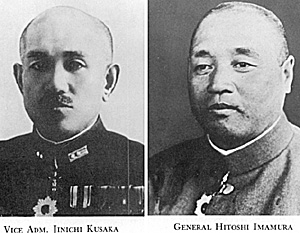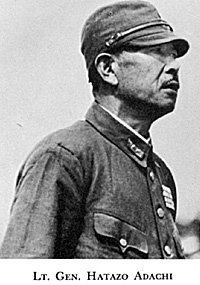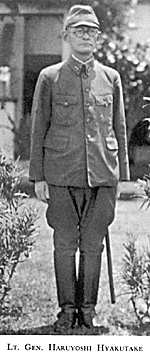Just as the Allies were determined to advance against Rabaul, the Japanese were determined to hold it, and, indeed, to continue the advance that had been checked at Guadalcanal and Buna. The importance imparted to Rabaul by its airfield sites and harbor, as well as by its strategic location, had long been recognized by the Japanese. Imperial General Headquarters' instructions of November 1941 directed the capture of Rabaul at the earliest opportunity after the fall of Guam. (Unless otherwise indicated all data on the Japanese in this chapter are derived from the following monographs in the series Japanese Studies in World War II: 17th Army Operations, Vol. II, Monogr NO. 40 (OCMH); 18th Army Operations, Vols. I, II, Monogrs No. 41, 42 (OCMH); Southeast Area Naval Operations, Vols. I-III, Monogrs No. 48-50 (OCMH); History of the Army Section, Imperial General Headquarters, 1941-45, Monogr No. 72 (OCMH); Outline of Southeast Area Naval Air Operations, November 1942-June 1943, Pt. III, Monogr No. 107 (OCMH); and 8th Area Army Operations, Monogr No. 110 (OCMH). Monograph No. 110 is a greatly improved revision of History of the 8th Area Army, 1942-44, Monograph No. 37 (OCMH).)
Rabaul supported the offensives against the Allied lines of communication, and defensively was a bastion which would help defend the Caroline Islands, the Netherlands Indies, and the Philippines against attack from the south. It was one of the most important bases in the semicircular string of island fortresses that stretched from Burma through the Indies and the Bismarck Archipelago to the Marshall Islands, thence north and northwest to the Kuriles. (For early Japanese planning see Morton, The Fall of the Philippines, PP. P-61; Milner, Victory in Papua; Miller, Guadalcanal: The First Offensive, PP- 4-7.)
Japanese Command and Strategy
By late 1942 Rabaul had been developed into the major air and naval base in the Japanese Southeast Area, and was the site of the highest headquarters in that area. Although smaller than most Allied areas in the Pacific, the Southeast Area was huge. Its western boundary, as set on 2 April 1943, was longitude 140 degrees. (From 7 January to 2 April 1943, the western boundary was the border of Dutch and Australian New Guinea-longitude 141 degrees east. In addition to Japanese sources cited see U.S. Strategic Bombing Survey, The Allied Campaign Against Rabaul (Washington, 1946), pp. 10, 83)
The northern boundary ran from 140 degrees east just north of the Equator to a line drawn between Kapingamarangi in the Greenwich Islands to Nauru, thence southeast between the Fijis and Samoa. It thus embraced parts of both the South and Southwest Pacific Areas.
Unlike the Allied areas, the Southeast Area did not possess a unified command. The highest Army and Navy headquarters co-operated closely with one another, but were responsible to different higher authorities.
 VICE ADM. JINICHI KUSAKA and GENERAL HITOSHI IMAMURA
VICE ADM. JINICHI KUSAKA and GENERAL HITOSHI IMAMURA
In charge of Army operations in eastern New Guinea, the Bismarck Archipelago, and the Solomons was General Hitoshi Imamura, commanding the 8th Area Army with headquarters at Rabaul. Imamura was responsible to the Army Section of Imperial General Headquarters. The naval command was the Southeast Area Fleet or the Southeastern Fleet led by Vice Adm. Jinichi Kusaka. His immediate superior was the Commander in Chief of the Combined Fleet but on several occasions he seems to have dealt directly with Tokyo.
By the time the Guadalcanal and Papuan campaigns ended, the 8th Area Army included two field armies and one air division. The 17th Army operated in the Solomons; the 18th Army was to be responsible for the campaigns in eastern New Guinea. The 6th Air Division, with headquarters at Rabaul, generally operated in New Guinea under the tactical direction of the 18th Army.
Under the Southeastern Fleet were the land-based 11th Air Fleet, which operated principally in the Solomons, and the 8th Fleet with bases at Rabaul and in the Shortlands-Buin area. The 8th Fleet, whose strength and composition varied considerably, usually included cruisers, destroyers, submarines, transports., and naval base forces. An administrative rather than a battle fleet, its primary duties were patrol and escort. Largescale combat operations were the mission of either the 3d or the Combined Fleet, both then at Truk. (USSBS, The Allied Campaign Against Rabaul, PP-11, 43-44)
Both the 8th Area Army and the Southeastern Fleet had been set up in late 1942 when the Japanese, making their major offensive effort in the Solomons and still planning to drive the Americans from Guadalcanal, realized that they had to commit large forces to attain success. But Imperial General Headquarters then revised its strategy and decided to abandon Guadalcanal, evacuate the survivors, and withdraw to strong positions in front of Rabaul.
Under the revised strategy, Imperial Headquarters decided to shift its emphasis from the Solomons to New Guinea. A policy of "active defense" would be pursued in the Solomons in order to reinforce New Guinea and pursue an "aggressive offensive" there. (Southeast Area Naval Operations, I, Japanese Monogr No. 48 (OCMH), 55.) Lae, Salamaua, Wewak, and Madang on New Guinea's north coast were specifically mentioned as bases to be held.
 LT. GEN. HATAZO ADACHI
LT. GEN. HATAZO ADACHI
Imamura therefore ordered Lt. Gen. Hatazo Adachi, commander of the 18th Army, to strengthen Lae, Salamaua, Wewak, and Madang. These points were valuable as harbors, airfield sites, or both. Lae and Salamaua were of great importance as their possessor could dominate Dampier and Vitiaz Straits and thus block any attempt to advance along the New Guinea coast to the Philippines or any other place in the Greater East Asia CoProsperity Sphere. The Japanese were determined not to yield "an operational route for the proclaimed enemy Philippines invasion." (18th Army Operations, I, Japanese Monogr No. 41 (OCMH), 55-56.)
These bases would also be necessary to the Japanese if they were to realize their hopes of capturing Port Moresby.
Thus the Japanese survivors of Buna were ordered to Salamaua, and on imamura's orders Adachi directed more elements of his army to move from Rabaul to the New Guinea bases. The 20th Division began moving to Wewak; the 41st sent elements to Madang, and part of the 51st Division was sent to Lae and Salamaua. The fixing of the west boundary of the Southeast Area on 7 January at the Dutch border apparently gladdened Adachi's heart. After being limited to the Buna region, "having suddenly obtained freedom of the operational area, it gave them [the 18th Army] bright and desirous hopes . (Ibid., p. 110.)
At the same time, detachments of Field Marshal Count Hisaichi Terauchi's Netherlands Indies-based Southern Army were occupying areas along New Guinea's north coast from the Vogelkop Peninsula to Hollandia.
Imperial Headquarters' orders for the Solomons required the 8th Area Army, in co- operation with the Southeastern Fleet, to hold the central and northern Solomons. Army and Navy authorities at Rabaul disagreed over exactly where the forward defense lines should be located. The Army favored the Bougainville area, holding that it would be too difficult to supply the islands farther south. The Navy insisted on New Georgia and Santa Isabel as outposts for Bougainville. Each service went its own way. The Army assumed responsibility for the defense of the northern Solomons. The Navy took over land defense of the central Solomons.
 Lt. Gen. Haruyoshi Hyakutake
Lt. Gen. Haruyoshi Hyakutake
Imamura gave to Lt. Gen. Haruyoshi Hyakutake's 17th Army, then consisting chiefly of the 6th Division, responsibility for Bougainville and adjacent islands. (Of the 17th Army units which served on Guadalcanal, the 35th Brigade (Kawaguchi Force or Detachment) went to Burma; the 2d Division, to the Philippines; the 38th Division, to New Britain under direct control of the 8th Area Army.)
Having insisted on the necessity for holding New Georgia and Santa Isabel, naval authorities then complained that this responsibility placed an excessive demand on naval strength, and asked Imamura for some Army ground troops for New Georgia in addition to the few who were already there. The general, still invoking the difficulty of supply, was at first reluctant. In March the Southeastern Fleet sent the 8th Combined Special Naval Landing Force to New Georgia, and another, the 7th, to Santa Isabel. (Composed of the Kure 6th and the Yokosuka 7th Special Naval Landing Forces, the 8th Combined had been activated in Japan for service on Guadalcanal but did not get there before the evacuation.)
After a good deal of negotiation, and perhaps on orders from Imperial Headquarters, Imamura acceded to Kusaka's requests and sent more Army troops to New Georgia under their own headquarters, the Southeastern Detachment, and some additional units to Santa Isabel. Both the 8th Combined Special Naval Landing Force and the Southeastern Detachment, as well as the Santa Isabel force, were under the tactical control of the 8th Fleet.
Thus in early 1943 the Japanese were holding a network of mutually supporting air and naval bases arranged in depth, running in two converging arcs through New Guinea and the Solomons to Rabaul. From the defensive point of view, these positions would serve to protect Rabaul, the Netherlands Indies, and the Philippines. Offensively, these bases could support advances southward, and although the Japanese had decided on delaying action in the Solomons, they were determined to take the offensive in New Guinea.
More The Japanese
- Command and Strategy
Japanese Offensives: January-June 1943
The I Operation: March-April 1943
Japanese Strength and Dispositions: June 30, 1943
Back to Table of Contents -- Operation Cartwheel
Back to World War Two: US Army List of Issues
Back to MagWeb Magazine List
© Copyright 2002 by Coalition Web, Inc.
This article appears in MagWeb (Magazine Web) on the Internet World Wide Web.
Other military history articles and gaming articles are available at http://www.magweb.com